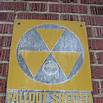
Gimme Shelter
The sign is still there on the side of the school. It has a piece missing from the bottom left hand corner and the rest of it has buckled and does not lie true against the brick wall it was drilled to many decades ago. The black paint has worn away entirely leaving the milky silver color of the metal beneath, but the yellow paint weathered the passing years better (it’s the old “chrome yellow,” full of lead) and you can still see the three upside down triangles in the circle that once was black. You can still read the lettering “Fallout Shelter” in yellow on the bottom of the sign.
From time to time students notice it and ask me what it is and you have to think exactly what you should tell them. When I first started working at the school, I used to tell a story that sounded a lot like a fairy tale. “A long time ago when I was your age, we used to sit in the basements of our schools practicing in case…” This is usually where I would pause and try to decide how to explain what I had exactly been practicing. Should I have told them it was in case the Russians came to bomb us? These children didn’t know who the Russians were and would have been incredulous and frightened at the idea of planes raining death upon them from the skies above. Should I have told them that when I was doing it I had no idea what I was doing it for? Should I have told them I now thought it was all pretty stupid, that had a nuclear bomb been dropped on us, sitting in the basement of our school would have been no protection at all? Usually, I ended up not telling them any of these things. I just said it was something that we didn’t do anymore. I told them that we should have taken the sign down a long time ago.
And then came 9/11 and the idea of planes carrying death inside them became part of the national narrative again and it was suddenly far too easy to make my students understand, not the old Cold War between East and West, of course, but the new one, the one waged by shadowy men who find our way of life repugnant, who feel that we have sullied theirs. Actually, it really isn’t all that easy to make them understand this either. Only the sense of danger is easy to explain. Danger is something a child can always understand.
So now I just say, very matter-of-fact, “When I was a kid, we had fallout drills, just like we have lock-downs now.”
This continuity of threat makes sense to them. They go home, if not comforted, then at least satisfied. They know they were not lied to.
And now, in the last few weeks, I have been forced to think about that old Cold War again, or the aspect of it that had us all huddled in fallout shelters in the first place, the prospect of nuclear war. North Korea, that last holdout of the old Cold War-style dictatorship seems suddenly to have gone wild, making grandiose threats, promising destruction to South Korea, Japan as well as the USA. Do they really mean the crazy things they say? Would they really make good on their threats? The pundits argue. Some say it’s all propaganda, a spoiled young man flexing his political and military muscle. Others argue we could be on the brink of nuclear war.
And what do I do? I check the world map quickly, reminding myself where everything is, taking comfort in the fact all the pundits are in agreement that the North Koreans cannot get a missile as far as where I live. So I don’t feel immediately threatened. If the tsunami hits, my house is high enough up the slope to escape the waves, but I watch and wait nevertheless, wondering, afraid not only of what may be coming but of what may be coming after that, for if the people who live below me go, it’s only a matter of time before I go, too.
The Korean War (1950- 1953), the war that never ended, seems almost like a fairy tale to us now. It is far less real to me, and I think to most Americans, than World War Two which took place before it. How many movies have you seen about the Korean War? I can think only of M*A*S*H. How many movies have you seen about World War Two (or World War One for that matter) or the Vietnam War? Too many to count. And that goes for books as well. The only novel I ever read that was set in Korea was William Salter’s The Hunters which isn’t even really set in Korea, but in the skies high above it, fighter pilots dodging and diving along the Yalu River. I cannot think of any seminal books about Korea the way I can so easily about Vietnam, nothing like Michael Herr’s Dispatches or Tim O’Brien’s If I Die in a Combat Zone.
And so I feel like I am somewhat without guide marks to understand the present crisis. I have no feeling for the Korean peninsula. My Korean history is shaky at best. I can listen to what the experts say, but it doesn’t make much sense to me. I don’t really understand. The pictures of crazed North Korean troops running hysterically after Kim Jong-un on the beaches of North Korea have the amateurish quality of home movies and frighten me more than all the wild talk. How cut off are the North Koreans, how out of whack with the rest of the world, that they make and publish videos which wouldn’t convince one of my fourth graders?
Ambassador Kerry is making the rounds of Asia right now, China first, trying to get the Chinese to get the North Koreans to back off. He’s offering to remove missile defense systems if by some miracle we can rid the Korean peninsula of nuclear weapons. Can we really do that?
Nuclear weapons. Fallout shelters. Now, suddenly I’m thinking about them again. Frankly, I thought the world had moved on to twenty-year-olds with bombs in their underwear or arsenals in their basements. But I guess the old bogeymen never really go away. It makes me feel like a kid again, back to the days of bright orange pedal-pushers, bangs in my eyes and the “Russian threat”. It makes me wish that my kids at school could at least escape this new-old fear, the nightmare of total annihilation, or less than total annihilation but a world poisoned by radioactive fallout, a world none of wants to live in, surely not even the North Koreans.





I remember those “air raid” drills too. I thanked God for many years when my boys were young that they did not have that cloud of doom over them. But now it has shifted again. That dangerous pendulum.
Last night, while visiting a dear friend and watching the reports on the Boston Marathon bombing on NBC Nightly News, I kept tearing up. She commented it was hard to feel such fear but I said, no, it’s not Fear, it’s Grief. I feel such sadness that we humans are so barbaric to one another and have always been so. It’s taken different forms over our history, but it boggles my mind that we’ve been so consistently downright MEAN to one another. We have such capacity for love and open hearted exchange and can only imagine what our world would be like if that were the main driving force. I guess we can only find that place inside in each of our own little lives to find that. Will it ever successfully counter the shadow side?